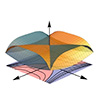| Nov 29, 2024 |
|
(Nanowerk News) Physicists at Loughborough University have made an exciting breakthrough in understanding how to fine-tune the behaviour of electrons in quantum materials poised to drive the next generation of advanced technologies.
|
|
Their findings are published in Nature Communications (“On the engineering of higher-order Van Hove singularities in two dimensions”).
|
 |
| (a) A top-down view of a single layer of Sr2RuO4, the blue square highlights the slight rotations of RuO6 octahedra at the surface of the material. (b) A 3D visualisation showing how rotated RuO6 octahedra result in changes of the electron energy bands at the surface of the material, with a higher-order Van Hove singularity (HOVHS) occurring at the middle point. (Image: © Nature Communications)
|
|
Quantum materials, like bilayer graphene and strontium ruthenates, exhibit remarkable properties such as superconductivity and magnetism, which could revolutionise areas like computing and energy storage.
|
|
However, these materials are not yet widely used in real-world applications due to the challenges in understanding the complex behaviour of their electrons – the particles that carry electrical charge.
|
|
In quantum materials, electrons interact strongly and intricately, often losing their individual identity and instead cooperating in complex, unpredictable ways.
|
|
While these interactions are responsible for the unique properties of quantum materials, they also make them highly sensitive to environmental changes —such as variations in temperature, pressure, or magnetic fields — which can lead to significant and unpredictable shifts in their behaviour.
|
|
Researchers are working to better understand and control these electron interactions to unlock the potential of quantum materials for next-generation technologies.
|
|
One promising approach involves Van Hove singularities (VHs), specific points in a material’s ‘band structure’.
|
|
The band structure acts as a map showing where electrons can move and how fast they can travel in a material. VHs are locations on this map where electrons cluster, forming regions that are highly sensitive to changes in the environment.
|
|
High-order Van Hove singularities (HOVHS) are a type of VH of particular research interest as they are exceptionally sensitive to subtle changes.
|
|
Scientists are keen to explore how HOVHs can be manipulated to fine-tune a material’s properties.
|
|
However, understanding of HOVHs remains limited, including in determining where they occur in materials and the factors that drive their formation.
|
|
Theoretical physics is therefore essential to progressing research in this area and researchers at Loughborough have had an exciting breakthrough with the method they have developed to detect and analyse HOVHs.
|
|
The method, developed by a team led by Professor Joseph Betouras, draws on the Feynman-Hellmann theorem, a principle in quantum mechanics that examines how energy changes in a system when certain parameters are varied.
|
|
In a new Nature Communications paper, the researchers have demonstrated their method by applying it to strontium ruthenate (Sr2RuO4), a well-known metal with complex electronic properties.
|
|
Using a combination of theoretical and computational modelling, and experimental data provided by the University of St Andrews, the team detected and analysed HOVHs, revealing how structural differences at the material’s surface give rise to HOVHs absent in the bulk of the material.
|
|
The findings show that HOVHs occur exclusively at the surface of strontium ruthenate due to slight rotations in the material’s building blocks, ‘RuO6 octahedra’.
|
|
Building on these insights, the researchers have provided a theoretical prediction on how modifications to the surface structure can alter the nature of HOVHs, with potential applicability not only to strontium ruthenate but also to other quantum materials.
|
|
The researchers suggest that experimental studies should now focus on testing these predictions by engineering such structural modifications, which could help validate the method and pave the way for tailoring advanced quantum materials for next-generation electronic technologies.
|
|
Of the study’s importance, Professor Joseph Betouras said: “This research area can be thought of as equivalent to engineering and design in the world of quantum materials.
|
|
“Thanks to our research, it is now possible to envision methods to create these types of singularities to alter the material’s electronic and magnetic properties.
|
|
“This could, for example, enable the creation of superconductors—materials where electrons flow without resistance—at temperatures approaching room temperature.”
|
|
Dr Anirudh Chandrasekaran, the lead author of the Nature Communications paper, added: “This paper introduces a new set of tools to engineer structures with higher-order Van Hove singularities in quantum materials.
|
|
“This could enable phenomena such as superconductivity and magnetism with greater efficiency. This work will, therefore, aid in the discovery of novel materials for technological applications.”
|
|
The Loughborough researchers now plan to build on this research by understanding the phenomenon of superconductivity around higher-order Van Hove singularities, among other things.
|


